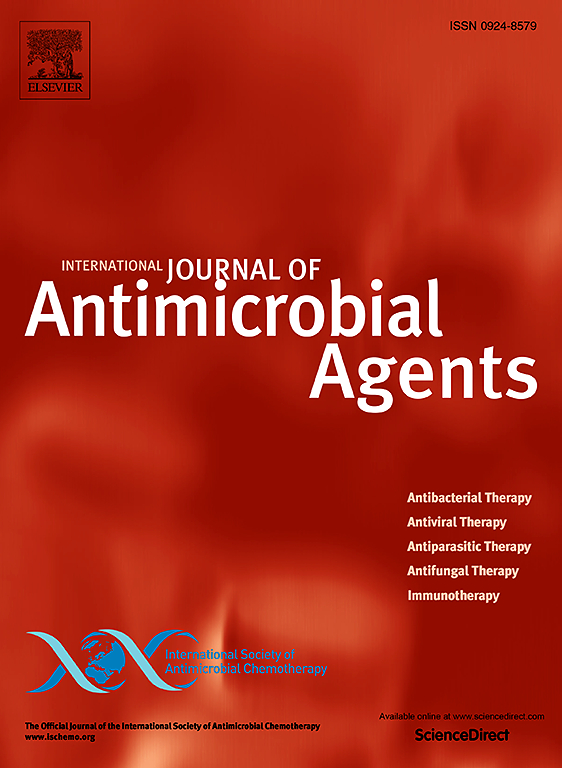利用机器学习工具设计的具有高溶解度和低红细胞毒性的新型活性富含色氨酸和精氨酸的抗菌肽。
IF 4.9
2区 医学
Q1 INFECTIOUS DISEASES
International Journal of Antimicrobial Agents
Pub Date : 2025-01-01
DOI:10.1016/j.ijantimicag.2024.107399
引用次数: 0
摘要
鉴于耐多药细菌(MDR)数量的不断增加,有必要设计高活性、非溶血性和高可溶性的合成抗菌肽(amp),以替代不再有效或用作最后手段的抗生素。机器学习工具可以直接在计算机上识别非溶血性抗菌肽。在这里,我们利用这些工具从两个文库中对最佳肽进行了排名:1)8192个序列为bhxxbhbGAL的肽,其中b为碱性氨基酸R或K, h为疏水氨基酸,即G, a, L, F, I, V, Y或W, x为Q, S, a或V;2) 512个序列为RWhxbhRGWL的肽段,其中b和h为第一个文库,x为Q、S、A或g。每个文库中前100个序列和10个预测有活性但有溶血作用的肽段(共220个肽段)被SPOT合成,并测定其对金黄色葡萄球菌美国300 (MRSA)的IC50值。其中,具有低IC50值的6种抗菌肽在以下方面具有进一步的特征:抗MRSA、粪肠球菌、肺炎克雷伯菌、大肠杆菌和铜绿假单胞菌的mic;红细胞裂解;哺乳动物和细菌模型膜的二级结构;以及对癌细胞HepG2、CHO和PC-3的活性。总的来说,该方法产生了一大家族具有高溶解度和低红细胞毒性的活性抗菌肽。它还为未来的设计和改进的机器学习工具提供了一个框架。本文章由计算机程序翻译,如有差异,请以英文原文为准。
Novel active Trp- and Arg-rich antimicrobial peptides with high solubility and low red blood cell toxicity designed using machine learning tools
Background
Given the rising number of multidrug-resistant (MDR) bacteria, there is a need to design synthetic antimicrobial peptides (AMPs) that are highly active, non-hemolytic, and highly soluble. Machine learning tools allow the straightforward in silico identification of non-hemolytic antimicrobial peptides.
Methods
Here, we utilized a number of these tools to rank the best peptides from two libraries comprised of: 1) a total of 8192 peptides with sequence bhxxbhbGAL, where b is the basic amino acid R or K, h is a hydrophobic amino acid, i.e. G, A, L, F, I, V, Y, or W and x is Q, S, A, or V; and 2) a total of 512 peptides with sequence RWhxbhRGWL, where b and h are as for the first library and x is Q, S, A, or G. The top 100 sequences from each library, as well as 10 peptides predicted to be active but hemolytic (for a total of 220 peptides), were SPOT synthesized and their IC50 values were determined against S. aureus USA 300 (MRSA).
Results
Of these, 6 AMPs with low IC50’s were characterized further in terms of: MICs against MRSA, E. faecalis, K. pneumoniae, E.coli and P. aeruginosa; RBC lysis; secondary structure in mammalian and bacterial model membranes; and activity against cancer cell lines HepG2, CHO, and PC-3.
Conclusion
Overall, the approach yielded a large family of active antimicrobial peptides with high solubility and low red blood cell toxicity. It also provides a framework for future designs and improved machine learning tools.
求助全文
通过发布文献求助,成功后即可免费获取论文全文。
去求助
来源期刊
CiteScore
21.60
自引率
0.90%
发文量
176
审稿时长
36 days
期刊介绍:
The International Journal of Antimicrobial Agents is a peer-reviewed publication offering comprehensive and current reference information on the physical, pharmacological, in vitro, and clinical properties of individual antimicrobial agents, covering antiviral, antiparasitic, antibacterial, and antifungal agents. The journal not only communicates new trends and developments through authoritative review articles but also addresses the critical issue of antimicrobial resistance, both in hospital and community settings. Published content includes solicited reviews by leading experts and high-quality original research papers in the specified fields.

 求助内容:
求助内容: 应助结果提醒方式:
应助结果提醒方式:


